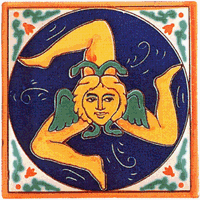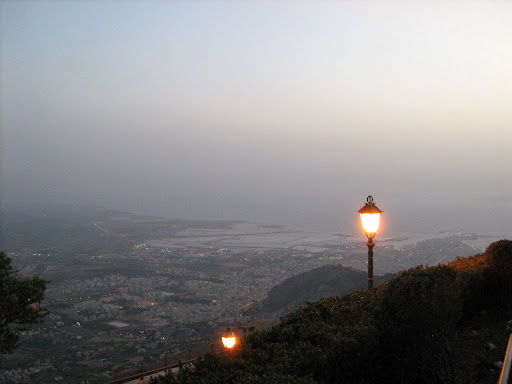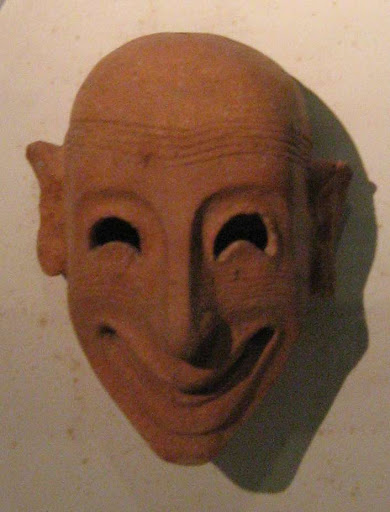Arrivederci Sicilia!
Binah, your faithful traveling correspondent, recently took a big trip to the Mediterranean. His first stop was Sicily, the Mediterranean's largest island. It sits just west and south of the Italian "boot."
I stayed my week there at the small mountain town in Sicily's northwest called Erice, overlooking the western sea. A group of us attending a scientific conference were whisked from the airport at Palermo (on Sicily's north coast) on an hour-plus drive to the west, the final part being a steep climb into the coastal mountains. The scientific center at Erice, home to conferences, workshops, and summer schools, is named after a young Sicilian science prodigy, Ettore Majorana, who mysteriously disappeared in 1938. (He made a small number of highly important contributions to the then-burgeoning science of elementary particles and forces.)
 This southwest-facing coast is not as famous as the Greek-influenced southeast corner and lacks its own Mount Etna. But you've heard of some of this part of Sicily, although perhaps not with that association. It's a part of the island first colonized by the Carthaginians around 800 BCE, itself a North African colony founded in 814 BCE by the Phoenician city of Tyre back in what is today Lebanon. Sicily is three-cornered, with coasts facing north, southwest, and southeast. The northern coast was originally the least developed part, the home of a mysterious people the Romans called the Siculi, for whom the island was named. Over the millennia, Sicily has been ruled by Carthaginians, Greeks, Romans, Greeks again, Arabs from North Africa, the Normans, the Spanish, and finally by the modern Italian republic.
This southwest-facing coast is not as famous as the Greek-influenced southeast corner and lacks its own Mount Etna. But you've heard of some of this part of Sicily, although perhaps not with that association. It's a part of the island first colonized by the Carthaginians around 800 BCE, itself a North African colony founded in 814 BCE by the Phoenician city of Tyre back in what is today Lebanon. Sicily is three-cornered, with coasts facing north, southwest, and southeast. The northern coast was originally the least developed part, the home of a mysterious people the Romans called the Siculi, for whom the island was named. Over the millennia, Sicily has been ruled by Carthaginians, Greeks, Romans, Greeks again, Arabs from North Africa, the Normans, the Spanish, and finally by the modern Italian republic. August in Sicily is hot, tending toward the humid, with strong sea breezes. But Sicily is also subject to the powerful north African scirocco wind, headed northward from the Sahara in the late summer and loaded with atmospheric dust, and we had three or four days of it later in the week. Erice boasts a mountain cable car both exciting and useful. It runs up and down the mountain all day and well into the evening, acting as Erice's main public transportation to the port city of Trapani - unless the scirocco shuts it down. It did for part of my stay.
August in Sicily is hot, tending toward the humid, with strong sea breezes. But Sicily is also subject to the powerful north African scirocco wind, headed northward from the Sahara in the late summer and loaded with atmospheric dust, and we had three or four days of it later in the week. Erice boasts a mountain cable car both exciting and useful. It runs up and down the mountain all day and well into the evening, acting as Erice's main public transportation to the port city of Trapani - unless the scirocco shuts it down. It did for part of my stay. In spite of the heat, I walked all around our mountain town of Erice every day, enjoying the amazing Sicilian food, and took a part of day to hike down to Trapani. Next to Trapani is the better-known city of Marsala, home of the famous wine, salt, and chicken. Salt has been harvested there from the sea for almost three millenia, starting with the Phoenicians. Marsala wine (fortified and aged like port) was invented by English wine merchants in the late 18th century. A later wine merchant, Joseph Whitaker, bought the island of Mozia in Marsala harbor. He started excavations there just before World War One. While the island was donated by the Whitaker family to Sicily about 30 years ago, the excavations continue, and what's been dug up is now preserved in a museum at the site.
In spite of the heat, I walked all around our mountain town of Erice every day, enjoying the amazing Sicilian food, and took a part of day to hike down to Trapani. Next to Trapani is the better-known city of Marsala, home of the famous wine, salt, and chicken. Salt has been harvested there from the sea for almost three millenia, starting with the Phoenicians. Marsala wine (fortified and aged like port) was invented by English wine merchants in the late 18th century. A later wine merchant, Joseph Whitaker, bought the island of Mozia in Marsala harbor. He started excavations there just before World War One. While the island was donated by the Whitaker family to Sicily about 30 years ago, the excavations continue, and what's been dug up is now preserved in a museum at the site.For Americans, Sicily brings up a cluster of outdated stereotypes of organ-grinders, heavy tomato-based cooking, and the Mafia. (Most Italian-Americans are of southern Italian extraction - Sicilian and Calabrese - because the south was and is the poorest part of Italy.) The Mafia is a leftover of the days when Sicily was ruled by foreigners. Most of its power has been broken in a campaign that has gone on in fits and starts since the days of Mussolini. I didn't see any organ-grinders, but the cocina Siciliana (like the architecture) shows an interesting mix of Greek, Arab, mainland Italian, and French influences. Couscous with local fish is a regional signature. Tomatoes are still ubiquitous. Erice is famous for its ultrasweet marzipan and mustazzuoli.
Much of the island's infrastructure is new. Sometimes I thought I was in California. The regional and Italian governments, plus the EU, have clearly been at work. Modern industries like wine and food export and tourism have also made a large mark. Sicily is still poor compared to northern Italy, but the gap is much smaller than in centuries past.


0 Comments:
Post a Comment
<< Home